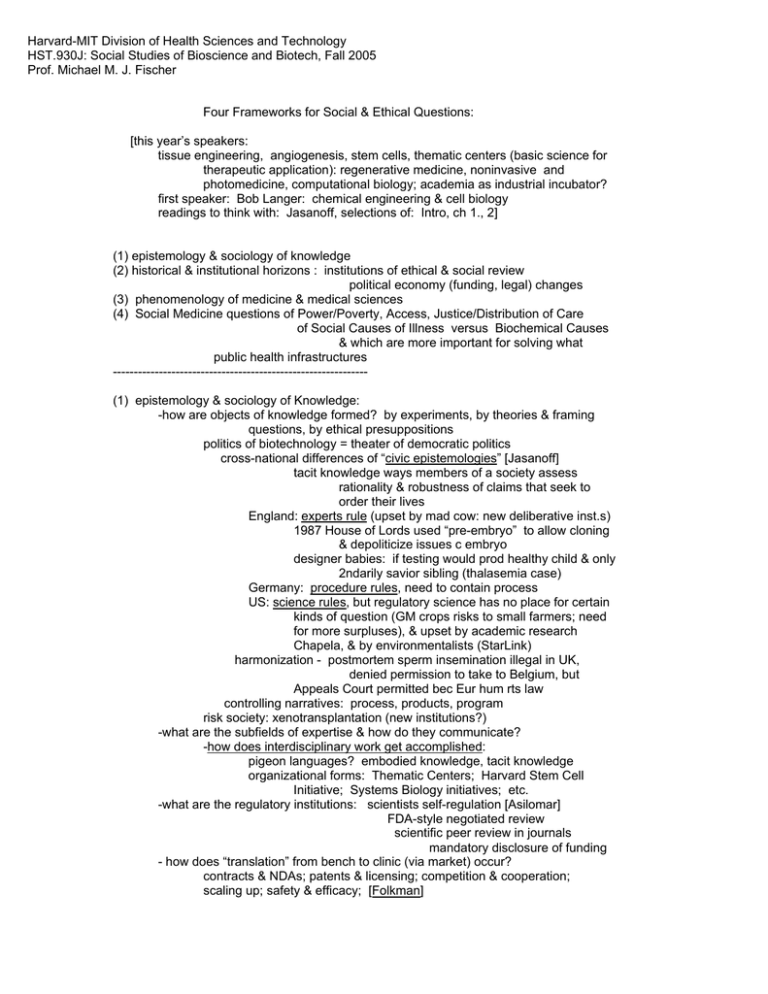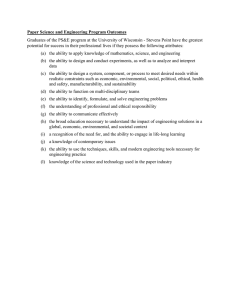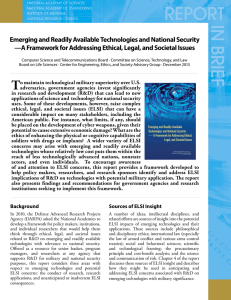Harvard-MIT Division of Health Sciences and Technology
advertisement

Harvard-MIT Division of Health Sciences and Technology HST.930J: Social Studies of Bioscience and Biotech, Fall 2005 Prof. Michael M. J. Fischer Four Frameworks for Social & Ethical Questions: [this year’s speakers: tissue engineering, angiogenesis, stem cells, thematic centers (basic science for therapeutic application): regenerative medicine, noninvasive and photomedicine, computational biology; academia as industrial incubator? first speaker: Bob Langer: chemical engineering & cell biology readings to think with: Jasanoff, selections of: Intro, ch 1., 2] (1) epistemology & sociology of knowledge (2) historical & institutional horizons : institutions of ethical & social review political economy (funding, legal) changes (3) phenomenology of medicine & medical sciences (4) Social Medicine questions of Power/Poverty, Access, Justice/Distribution of Care of Social Causes of Illness versus Biochemical Causes & which are more important for solving what public health infrastructures ------------------------------------------------------------(1) epistemology & sociology of Knowledge: -how are objects of knowledge formed? by experiments, by theories & framing questions, by ethical presuppositions politics of biotechnology = theater of democratic politics cross-national differences of “civic epistemologies” [Jasanoff] tacit knowledge ways members of a society assess rationality & robustness of claims that seek to order their lives England: experts rule (upset by mad cow: new deliberative inst.s) 1987 House of Lords used “pre-embryo” to allow cloning & depoliticize issues c embryo designer babies: if testing would prod healthy child & only 2ndarily savior sibling (thalasemia case) Germany: procedure rules, need to contain process US: science rules, but regulatory science has no place for certain kinds of question (GM crops risks to small farmers; need for more surpluses), & upset by academic research Chapela, & by environmentalists (StarLink) harmonization - postmortem sperm insemination illegal in UK, denied permission to take to Belgium, but Appeals Court permitted bec Eur hum rts law controlling narratives: process, products, program risk society: xenotransplantation (new institutions?) -what are the subfields of expertise & how do they communicate? -how does interdisciplinary work get accomplished: pigeon languages? embodied knowledge, tacit knowledge organizational forms: Thematic Centers; Harvard Stem Cell Initiative; Systems Biology initiatives; etc. -what are the regulatory institutions: scientists self-regulation [Asilomar] FDA-style negotiated review scientific peer review in journals mandatory disclosure of funding - how does “translation” from bench to clinic (via market) occur? contracts & NDAs; patents & licensing; competition & cooperation; scaling up; safety & efficacy; [Folkman] (2) historical-institutional horizons: - changes in ethical & social review: Nuremburg Code (1947): 10 paragraphs, #1 voluntary consent Belmont Report (1979): Ethical Principles and Guidelines for Research Involving Human Subjects (under National Research Act 1974) (Informed Consent) -respect for persons: -individuals be treated as autonomous subjects -protection for those with diminished autonomy (Risk/Benefit analyses) -beneficence -do no harm -maximize possible benefits, minimize possible harm -justice: fairness in distribution of benefits (Guidelines for Selection of Subjects) Helsinki Declaration (1964, and periodically revised, updated, 32 para.s) #19: Medical research only justified if reasonable likelihood that the populations in which the research is carried out stand to benefit from the results of the research. Department of Health & Human Services Guidelines for IRBs 1975 Asilomar Conference – recombinant DNA focused concern exclusively on safety/containment dropped from public debate “deliberate release” into environment of genetically engineered organisms (arose again 1980s: first with bovine growth hormone, then with genetically engineered corn, soya, etc., & Terminator technology) ELSI (3-5% of Human Genome Project funds, NIH & DoE, set aside for ethical, legal, and social issues, eg genetic privacy/confidentiality; discrimination in employment/insurance; psychological impact, reproductive issues, property/commercialization controversies re. ELSI mandates (Jon Beckwith, Lori Andrews) bioethics: official vs unofficial for hire by companies (deCode), pioneering new technical & legal solutions for use of tissues & medical data banks (deCode, Ardais) role of Presidential commissions (Clinton’s NBAC; Bush’s PCBE) -as professionalized discipline -as medium of democratic deliberation cross-cultural: Germany protection of human dignity Britain: protection of space for research US: regulatory thrust at pt of delivery: risk primary conc patients given little say c technol design/production regulatory science – often delegated to private sector shieled from full public review (proprietary info) US: peer review fetishized as innocent of politics (Daubert) Eur: new modes of production Funtowicz & Ravetz: policy-relevant sci diff degrees certainty normal science for ordinary scientic research consultancy science: applic avail knowl -> well characterized problems post normal science: highly uncertain, contested knowl. generated in support of hlth, safety, envir needs extended peer review w multiple stakeholders Gibbons: Mode 2 Knowledge: integrity = social accountability Beck: 2nd order modernization, reflexive institutions -1980s “biotechnology revolution” & changing academic-industry-government relations funding: post World War II: government funding for biomedical research (NIH, NSF, DoD) replaces foundations as primary source; 1980s venture capital: market forces transform symbolic distance of science from commerce Bayh-Dole accelerates transfer of public science to entrepreneurial development, marketing, profit parapolitical modes of scientists’ self-regulation & containment of public debate (e.g. Asilomar) legal changes: knowledge becomes more guarded Intellectual Property don’t publish before patenting (versus earlier publish as quickly as possible to get scientific credit) 1980 Chakrabarty case: new life forms may be patented Universities obligated to report potentially patentable inventions 1980-84: biology patent applications rose by 300% 1990s: biotech companies survive only through alliances with large pharmaceutical companies partly due to capital flows, but also due to need to survive patent challenges -post 9/11/2001 “biowarfare defense” revolution? Darpa like funding from DoD and via NIH? fast-track funding/grant approvals, to get academic and private sector scientists to change career paths BioShield legislation (State of Union Address, 2003): market guarantees & Lieberman-Hatch bill: also industrial tax & patent benefits new biocontainment lab.s (Levels 3,4) for industrial scale research, eg BU increase bioscientists, medical & health experts among top policy makers (a new stage in “biopolitics”? [Foucault/Agamben]) NIH funding for biodefense R&D: FY 2001 = $50m; FY 2002 = $275m; FY 2003 = $1.7 billion (in all federal agencies, FY 2003: $3 billion allocated Ken Alibek: Manhattan Project to build immunity: enable immune system to defeat/temporarily hold off array of bioweapons (3) phenomenology of medicine & medical sciences [Byron Good] -dissociation & new integration: how does one learn to be a physician, or clinically informed medical scientist? -what new skills of seeing, speaking, and writing are required? -soteriology: the moral dramas of dealing with life&death questions -narratives of hope & the biotechnical embrace [Mary Jo Good] -how does psychiatry look in different cultural contexts, e.g. if you are practicing where spirits are real or part of common sense (4) Social Medicine: Power/Poverty, Access, Justice/Distribution of Care Social and biomedical causes of Illness (e.g. smoking) public health infrastructures, including how to create informed publics, but also how to organize delivery of world class care in impoverished settings: direct observation therapy(DOT) different clinical trials for different folks? placebo trials v standard of care ICH (Japanese & Asian bodies?)




